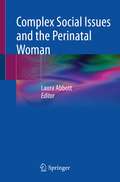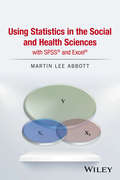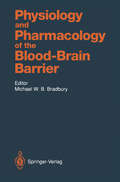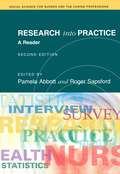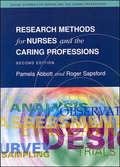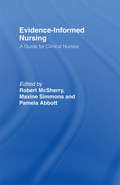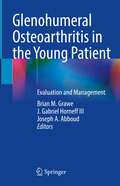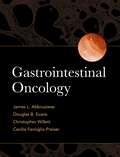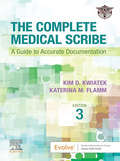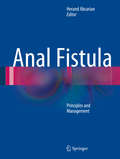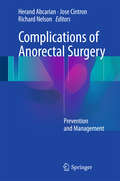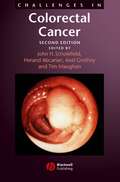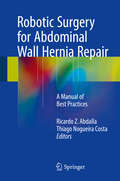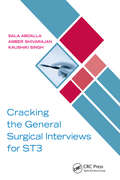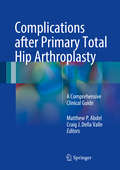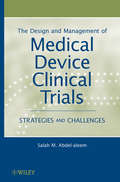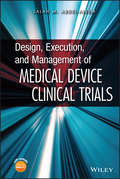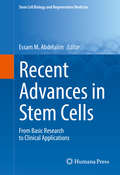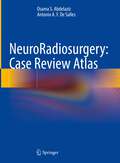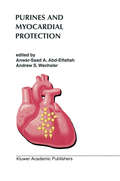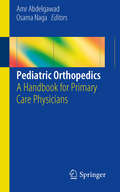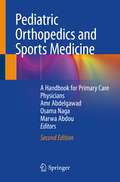- Table View
- List View
Complex Social Issues and the Perinatal Woman
by Laura AbbottPursuing a multidisciplinary approach, this book demonstrates the best quality care for pregnant women and new mothers who may have complex social needs. This book will benefit all health and social care professionals working in women’s health, while also providing a valuable reference guide for maternity departments. The latest Mothers and Babies: Reducing Risk through Audits and Confidential Enquiries across the UK (MBRRACE-UK) demonstrates the consequences that having multiple complexities has and the need to ensure that susceptible groups receive personalised, appropriate care and meeting the needs of all women is urgent and essential. This book brings together a blend of health and social care professionals, experts by experience and the charity third sector. All have expertise in caring for and supporting perinatal women with issues that may affect their health and the type of care they require. Through our collective writing, we provide a paradigm for partnership working and hope to have strengthened voices by highlighting women’s experiences and the importance of third sector partnerships, working in tandem with women who are experts by experiences and bringing health professionals together. In combination with recommendations from specialists in the field, we have offered a unique mix of compassion and evidence-based guidance. From substance abuse, domestic violence and HIV to experiences of Black, Asian and Ethnic Minorities, homelessness, women seeking asylum and women in prison, we have addressed a range of current issues and provided essential information and opportunities to reflect. Each chapter invites the reader to step into the shoes of the perinatal woman. Through our collective writing, we provide a paradigm for partnership working and hope to have strengthened voices by highlighting diverse experiences. We have looked at how using a trauma informed approach can be applied universally to care for all women and learn from charities such as Birth Companions, the 4M project and the Salamander Trust, how different approaches may directly impact women’s care in a positive and holistic way. An overarching aim of our book has been to find ways to deliver multi-agency continuity of care, whilst being aware of bias, professional responsibilities and an understanding how we can take a holistic approach - crucial for attaining excellence in 21st century maternity care provision.
Using Statistics in the Social and Health Sciences with SPSS and Excel
by Martin Lee AbbottProvides a step-by-step approach to statistical procedures to analyze data and conduct research, with detailed sections in each chapter explaining SPSS® and Excel® applications This book identifies connections between statistical applications and research design using cases, examples, and discussion of specific topics from the social and health sciences. Researched and class-tested to ensure an accessible presentation, the book combines clear, step-by-step explanations for both the novice and professional alike to understand the fundamental statistical practices for organizing, analyzing, and drawing conclusions from research data in their field. The book begins with an introduction to descriptive and inferential statistics and then acquaints readers with important features of statistical applications (SPSS and Excel) that support statistical analysis and decision making. Subsequent chapters treat the procedures commonly employed when working with data across various fields of social science research. Individual chapters are devoted to specific statistical procedures, each ending with lab application exercises that pose research questions, examine the questions through their application in SPSS and Excel, and conclude with a brief research report that outlines key findings drawn from the results. Real-world examples and data from social and health sciences research are used throughout the book, allowing readers to reinforce their comprehension of the material. Using Statistics in the Social and Health Sciences with SPSS® and Excel® includes: Use of straightforward procedures and examples that help students focus on understanding of analysis and interpretation of findings Inclusion of a data lab section in each chapter that provides relevant, clear examples Introduction to advanced statistical procedures in chapter sections (e.g., regression diagnostics) and separate chapters (e.g., multiple linear regression) for greater relevance to real-world research needs Emphasizing applied statistical analyses, this book can serve as the primary text in undergraduate and graduate university courses within departments of sociology, psychology, urban studies, health sciences, and public health, as well as other related departments. It will also be useful to statistics practitioners through extended sections using SPSS® and Excel® for analyzing data.
Using Statistics in the Social and Health Sciences with SPSS and Excel
by Martin Lee AbbottProvides a step-by-step approach to statistical procedures to analyze data and conduct research, with detailed sections in each chapter explaining SPSS® and Excel® applications This book identifies connections between statistical applications and research design using cases, examples, and discussion of specific topics from the social and health sciences. Researched and class-tested to ensure an accessible presentation, the book combines clear, step-by-step explanations for both the novice and professional alike to understand the fundamental statistical practices for organizing, analyzing, and drawing conclusions from research data in their field. The book begins with an introduction to descriptive and inferential statistics and then acquaints readers with important features of statistical applications (SPSS and Excel) that support statistical analysis and decision making. Subsequent chapters treat the procedures commonly employed when working with data across various fields of social science research. Individual chapters are devoted to specific statistical procedures, each ending with lab application exercises that pose research questions, examine the questions through their application in SPSS and Excel, and conclude with a brief research report that outlines key findings drawn from the results. Real-world examples and data from social and health sciences research are used throughout the book, allowing readers to reinforce their comprehension of the material. Using Statistics in the Social and Health Sciences with SPSS® and Excel® includes: Use of straightforward procedures and examples that help students focus on understanding of analysis and interpretation of findings Inclusion of a data lab section in each chapter that provides relevant, clear examples Introduction to advanced statistical procedures in chapter sections (e.g., regression diagnostics) and separate chapters (e.g., multiple linear regression) for greater relevance to real-world research needs Emphasizing applied statistical analyses, this book can serve as the primary text in undergraduate and graduate university courses within departments of sociology, psychology, urban studies, health sciences, and public health, as well as other related departments. It will also be useful to statistics practitioners through extended sections using SPSS® and Excel® for analyzing data.
Physiology and Pharmacology of the Blood-Brain Barrier (Handbook of Experimental Pharmacology #103)
by N. J. Abbott D. Barnes D. J. Begley A. L. Betz Michael W.B. Bradbury M. W. Brightman D. J. Brooks H. F. Cserr P. A. Fraser A. Gjedde G. W. Goldstein J. Greenwood N. H. Greig M. K. Gumerlock J. J. Laterra J-M. Lefauconnier P. J. Luthert D. K. Male E. A. Neuwelt C. S. Patlak O. E. Pratt S. I. Rapoport P. J. Robinson N. R. Saunders G. P. Schielke Q. R. SmithThe blood-brain barrier is still not completely understood and therefore the subject of fascinating study. How are endogenous substances transported through the blood-brain barrier? What are the known therapeutic and toxic agents? How are they transported across cerebral microvessels? The discussion of these and other questions with far-reaching consequences for all neuroscientists can be found in this volume. This authoritative and up-to-date review of the blood-brain barrier gives a proper understanding of the topic. The experimental principles, the results of very recent research, as well as the implications that experimental research has for clinical treatment are thoroughly covered. Information is given on: - new findings based on classical physiological and pharmacological techniques, - results obtained from brain capillaries in vitro and in culture, - results obtained from the new scanning techniques (PET and MRI), - the immunology of the blood-brain barrier, - trace metal transport, - the pathological breakdown of the barrier and - the modification of drugs to increase their entry into the brain. Here is a source of information that is invaluable to specialists concerned with basic research in the neurosciences, with the design of neuropharmacological agents, with the radiological diagnosis of cerebral pathology or with the treatment of cerebral lesions!
Research into Practice (UK Higher Education OUP Humanities & Social Sciences Health & Social Welfare)
by Pamela Abbott Roger SapsfordPraise for the first edition of Research Into Practice and Research Methods for Nurses and the Caring Professions:"These books provide a good introduction for the uninitiated to reading and doing research. Abbott and Sapsford provide a clearly written and accessible introduction to social research...One of their aims is to 'de-mystify' research, and in this they succeed admirably...After reading the text and the articles in the reader, and working through the various research exercises, readers should have a clear appreciation of how to evaluate other people's research and how to begin their own."- David Field, Journal of Palliative MedicineThis is a thoroughly revised and up-dated edition of the bestselling reader for nurses and the caring professions. It offers carefully selected examples of research, all concerned in some way with nursing or the study of health and community care. It illustrates the kind of research that can be done by a small team or a single researcher, without large-scale research grants. The editors have chosen papers which show a great diversity of approaches: differing in emphasis on description or explanation, different degrees of structure in design and different appeals to the authority of science or the authenticity of emphatic exploration. They show the limitations typical of small-scale projects carried out with limited resources and the experience of applied research as it occurs in practice, as opposed to how it tends to look when discussed in textbooks. The chapters have been organized into three sections representing three distinct types of social science research: observing and participating, talking to people and asking questions, and controlled trials and comparisons. Each section is provided with an editorial introduction.Features:Thoroughly revised and up-dated edition of bestselling textNew articles in line with latest trends in nursing and other practitioner research, with more stress on evidence-based practice, action research and self-evaluationNew user-friendly formatVery well-known authors in the field
Research Methods For Nurses And The Caring Professions (UK Higher Education OUP Humanities & Social Sciences Health & Social Welfare)
by Pamela Abbott Roger SapsfordPraise for the first edition of Research into Practice and Research Methods for Nurses and the Caring Professions:These books provide a good introduction for the uninitiated to reading and doing research. Abbott and Sapsford provide a clearly written and accessible introduction to social research ... One of their aims is to 'de-mystify' research, and in this they succeed admirably... After reading the text and the articles in the reader, and working through the various research exercises, readers should have a clear appreciation of how to evaluate other people's research and how to begin their own.-David Field, Journal of Palliative MedicineThis book, now substantially revised in its second edition, is about the appreciation, evaluation and conduct of social research. Aimed at nurses, social workers, community workers and others in the caring professions, the book is particularly focused on research which evaluates and contributes to professional practice. The authors have provided many short, practical exercises in the text, and the examples are drawn mostly from projects carried out by one or two people rather than large research teams. The clear, accessible style will make this the ideal introductory text for those undertaking or studying research for the first time.The book may be used in conjunction with Research into Practice (Open University Press), a reader of useful examples selected by the same authors.
Evidence-Informed Nursing: A Guide for Clinical Nurses
by Pamela Abbott Robert Mc Sherry Maxine SimmonsThis introductory text to evidence-based practice provides nurses and other health professionals with a clear idea of why they should use research information as a basis for high-quality patient care and how they should use that information in the clinical setting. In a logical progression which helps the student build knowledge systematically the text looks at:*the rationale for evidence-based care*what research is and approaches to it*the benefits of research to clinical practice*critical appraisal skills*reflective practice and decision-making*how to put research into practice*the importance of research disseminationA summary of essential points to remember is included at the end of each chapter and the text is firmly grounded in the clinical context. This book provides an indispensible reference guide suitable for use at all levels of training and practice.
Glenohumeral Osteoarthritis in the Young Patient: Evaluation and Management
by Joseph A. Abboud Brian M. Grawe J. Gabriel HorneffThe management of glenohumeral arthritis in the young patient remains a challenging problem for the treating clinician. The activity demands seen in such patient populations require a unique understanding of what the goals of treatment are to ensure satisfied and sustainable outcomes. In addition, younger patients have a longer life expectancy and more active lifestyles, which can negatively impact the longevity of arthroplasty implants that are traditionally used in the older patient population. As such, the discovery and implementation of novel and anatomy preserving techniques continue to evolve to meet the demand of younger patients without compromising their outcomes. This practical text serves to educate the treating clinician on how to recognize and categorize glenohumeral osteoarthritis in young patients and offers insight into the various operative and non-operative treatment options. Opening chapters examine the prevalence and burden, etiology and evaluation of the condition, followed by chapters discussing the current non-invasive and non-operative approaches to treatment, such as injection therapy. The main complement of chapters are detailed descriptions of surgical approaches, from arthroscopy and cartilage reconstruction to total and reverse shoulder arthroplasty, stemless approaches and arthrodesis. A final chapter expands on future management strategies. Radiographs and intraoperative photos are provided to enhance the text.Presenting the state of the art for this increasingly common condition, Glenohumeral Osteoarthritis in the Young Patient is an ideal resource for orthopedic surgeons and sports medicine specialists alike.
Gastrointestinal Oncology
by James L. Abbruzzese Douglas B. Evans Christopher G. Willett Cecilia Fenoglio-PreiserIn 74 chapters, Gastrointestinal Oncology brings together a diverse group of specialists to provide the most authoritative, up-to-date and encyclopedic volume currently available on the subject. The first part of this text introduces a series of concepts and topics taht are important to gastrointestinal malignancies in general. These topics include epidemiologic principles, prevention, screening, familial GI cancers, developmental and molecular biology, pathobiology, general therapeutic principles, emerging therapies, and palliative care. The second part of the book covers each of the specific cancers affecting the human gastrointestinal tract. These chapters are introduced by state of the art discussions outlining our current understanding of the pathobiology and molecular biology relevant to each cancer. Subsequent sections describe the multidisciplinary management of specific clinical situations. By organizing the treatment-related chapters around clinical scenarios, the reader will readily find the information necessary to effectively manage the complex clinical situations encountered by patients with gastrointestinal malignancies.
The Complete Medical Scribe, E-Book: The Complete Medical Scribe, E-Book
by ABC Scribes, LTDExpand your career opportunities with this concise, all-in-one guide to a dynamic and growing healthcare career! The Complete Medical Scribe: A Guide to Accurate Documentation, 3rd Edition provides the information you need to document patient health records accurately, thoroughly, and efficiently. Coverage includes activities such as creating a note, recording a patient history and review of systems, documenting diagnostic tests and therapeutic procedures, and noting follow-ups for labs or imaging. A strong foundational knowledge of anatomy and body systems is emphasized. Written by two medical doctors in conjunction with the experts at ABC Scribes, this comprehensive resource will prepare you to become an essential member of the healthcare team in a variety of settings. Comprehensive coverage includes everything you need to know to work as a medical scribe, including medical law and ethics, safety and infection control, health record documentation, billing and reimbursement requirements, medical terminology basics, and detailed body system coverage. Clinical scenarios represent common situations and promote real-world application of the scribe’s function. Case studies with questions test your comprehension and let you apply your knowledge to the clinical setting. Review questions and exercises within chapters and online provide opportunities for self-quizzing to identify areas of strength and areas of focus. Nearly 200 colorful medical illustrations and photos depict subjects such as anatomy and physiology as well as online charting within the electronic health record (EHR). Detailed instructional videos online simulate medical practice, using real doctor-patient encounters that progress logically through each part of the EHR. Notes boxes emphasize practice dos and don’ts along with on-the-job realities.
Anal Fistula: Principles and Management
by Herand AbcarianAnal Fistula: Principles and Management provides a comprehensive and state of the art review of major issues specific and related to the treatment of anal fistulas. An important section of the book covers the large number of alternative procedures which have been developed in the last two decades. Needless to say, none of these procedures have been uniformly successful, otherwise there would be no need for all the different operations. The book addresses each alternative procedure, discusses the benefits of each procedure, includes the most up-to-date results. Other important chapters cover the causes and failure of treatment and operations for fistulas. Also included is a Cochrane Review of all available randomized controlled trials with levels of evidence culled from the literature.Written by specialists in their respective fields, Anal Fistula: Principles and Management fills a void in available texts on a subject matter very commonly encountered by surgeons, physicians and specialists.
Complications of Anorectal Surgery: Prevention and Management
by Herand Abcarian Jose Cintron Richard NelsonThis text provides a comprehensive, sate of the art review of complications related to anorectal surgical procedures old and new. As anorectal surgery has evolved throughout the decades, newer and at times unexpected complications arise as of necessity. Any surgeon not familiar with these, may be perplexed as to how to manage these specific complications and more importantly how to avoid such complications in the course of their future practice. Complications of Anorectal Surgery: Prevention and Management provides a very helpful resource for all surgeons performing anorectal surgery and will be particularly useful for general surgeons practicing in rural or small urban settings where access to a colon and rectal specialist, a large medical center or a resource medical library may be scarce or limited.
Challenges in Colorectal Cancer
by Herand Abcarian Tim Maughan Axel Grothey John H. ScholefieldThe latest guidance on challenging and controversial aspects of colorectal cancer Colorectal cancer is one of the most common forms of cancer in the US and Europe. Thousands of people are diagnosed with the disease every year and nearly half of these die as a result. As colorectal cancer is curable when detected early, a significant proportion of these deaths could be prevented by earlier diagnosis. Much has changed since the publication of the first edition of this book in 2001: introduction of screening programs, improved diagnosis and surgery for rectal cancer, and advances in adjuvant and palliative medical therapy to name but a few. Challenges in Colorectal Cancer provides the most up-to-date information on the new and emerging treatments. The second edition looks at the total patient management of this condition and is aimed at the entire medical team caring for those with colorectal cancer. It also contains the latest guidelines on epidemiology and prevention of colorectal cancer, and the application of molecular genetics. The expanded international editor team present advice on surgical management, including new laparoscopic and endoscopic techniques and the role of the pathologist. They also review hot topics in colorectal cancer treatment, including the role of radiotherapy, options for chemotherapy and new developments in vaccines and immunotherapy.
Robotic Surgery for Abdominal Wall Hernia Repair: A Manual of Best Practices
by Ricardo Z. Abdalla Thiago Nogueira CostaThis book is a surgical manual, intended to present and discuss the use of robotic surgery for abdominal wall hernia repair. It comprises the most important surgical approaches in the field, presenting step by step procedures in a clear and didactic way. Abdominal wall hernias are very common conditions, easily identifiable in clinical practice and that usually require a surgical intervention as treatment. However, the choice for the right surgical procedure to treat those conditions may vary, provided the diversity on possible techniques, clinical presentations and complexity. Robotic surgery has emerged in recent years as an important tool to increase the number of surgical approaches for the surgeon who faces abdominal wall hernias. Video-assisted and robotic surgery may represent a consistent improvement in options available for the surgeon involved in wall hernia repair. Current robotic surgical techniques present several of the benefits of common laparoscopic surgery features (such as low invasiveness and fast recovery), and adds some other specific benefits, such as more dynamic and precise movements and a much better view of the operatory field. Robotic Surgery for Abdominal Wall Hernia Repair is intended to help surgeons to manage this disease from another point of view and to choose the best procedures in each case, pushing medical practice to another level of decisions, investigation and follow up, considering the use of new technologies in robotic surgery. It intends to be a reference manual to medical practitioners who has surgical skills in their backgrounds, but that are not familiar with the use of minimally invasive procedures for abdominal wall complex defects.
Cracking the General Surgical Interviews for ST3
by Sala Abdalla Amber Shivarajan Kaushiki SinghST3 interviews are extremely competitive and achieving the highest possible score is essential in securing the surgical training post of choice. The key to success in these interviews is through diligent preparation. This book outlines the structure and format of the ST3 general surgical interviews, with chapters dedicated to each component area that is assessed on the day. Written in an engaging style, it provides an essential resource for the interviews, with all of the required material in one book,a bonus for many readers with time constraints imposed by a demanding work schedule. It is aimed at instilling prospective surgeons with the tools and confidence needed to succeed at the ST3 general surgical interview. Success in these structured interviews will lead to the award of a ‘national training number’.
Cracking the General Surgical Interviews for ST3
by Sala Abdalla Amber Shivarajan Kaushiki SinghST3 interviews are extremely competitive and achieving the highest possible score is essential in securing the surgical training post of choice. The key to success in these interviews is through diligent preparation. This book outlines the structure and format of the ST3 general surgical interviews, with chapters dedicated to each component area that is assessed on the day. Written in an engaging style, it provides an essential resource for the interviews, with all of the required material in one book,a bonus for many readers with time constraints imposed by a demanding work schedule. It is aimed at instilling prospective surgeons with the tools and confidence needed to succeed at the ST3 general surgical interview. Success in these structured interviews will lead to the award of a ‘national training number’.
Complications after Primary Total Hip Arthroplasty: A Comprehensive Clinical Guide
by Matthew P. Abdel Craig J. Della ValleCovering both acute post-operative and chronic complications following total hip arthroplasty (THA), this comprehensive clinical guide provides diagnostic and management strategies and techniques for orthopedic surgeons at every level. Utilizing a case-based approach, each condition is discussed in terms of its epidemiology, risk factors, and preventative measures, with a brief literature review providing evidence for the diagnosis and treatment each author selects. The first section covers acute post-operative complications, discussing peripheral nerve and vascular injuries, periprosthetic fractures and infections as well as thromboembolic events. The second section covers chronic complications including the more common complications such as recurrent dislocation and infection as well as rarer complications such as pelvic discontinuity. Aimed at the most efficient management of these often complicated conditions, Complications after Primary Total Hip Arthroplasty is a practical resource for orthopedic surgeons, residents and fellows working with patients having undergone hip replacement surgery.
The Design and Management of Medical Device Clinical Trials: Strategies and Challenges
by Salah M. Abdel-aleemClinical trials tasks and activities are widely diverse and require certain skill sets to both plan and execute. This book provides professionals in the field of clinical research with valuable information on the challenging issues of the design, execution, and management of clinical trials, and how to resolve these issues effectively. It discusses key obstacles such as challenges to patient recruitment, investigator and study site selection, and dealing with compliance issues. Through practical examples, professionals working with medical device clinical trials will discover the appropriate steps to take.
Design, Execution, and Management of Medical Device Clinical Trials
by Salah M. Abdel-aleemAn essential introduction to conducting the various stages of medical device clinical trials Clinical research continues to be one of the most vital components of pharmaceutical, biostatistical, and medical studies. Design, Execution, and Management of Medical Device Clinical Trials provides a uniform methodology for conducting and managing clinical trials. Written in a style that is accessible to readers from diverse educational and professional backgrounds, this book provides an in-depth and broad overview for successfully performing clinical tasks and activities. Throughout the book, practical examples compiled from both the author's and other researchers' previous clinical trial experiences are discussed in a sequential manner as they occur in the study, starting from the development of the clinical protocol and the selection of clinical sites and ending with the completion of the final clinical study report. Next, readers are guided through the development of important clinical documents, including informed consent forms, case report forms, and study logs. A careful review of the Food and Drug Administration (FDA) and International Conference on Harmonisation (ICH) regulations applicable to medical devices is also featured. Additional coverage includes: Qualification and selection of investigators Study monitoring visits Definitions and reporting procedures for adverse events The use of biostatistical methodology in clinical research, including the use of biostatistics for sample size determination and study endpoints The roles and responsibilities of all members of a clinical research team The book concludes with an insightful discussion of special ethical conduct for human research and challenging issues to consider during the design of clinical studies. A glossary lists important clinical and statistical terms used in clinical research, and an extensive reference section provides additional resources for the most up-to-date literature on the topic. Design, Execution, and Management of Medical Device Clinical Trials is an excellent book for clinical research or epidemiology courses at the upper-undergraduate and graduate levels. It is also an indispensable reference for clinical research associates, clinical managers, clinical scientists, biostatisticians, pharmacologists, and any professional working in the field of clinical research who would like to better understand clinical research practices.
Recent Advances in Stem Cells: From Basic Research to Clinical Applications (Stem Cell Biology and Regenerative Medicine)
by Essam M. AbdelalimThis volume explores recent advances in the use of pluripotent stem cells (PSCs) and adult stem cells (ASCs) in basic and clinical applications. The chapters discuss use of PSCs for drug screening, genome editing, modeling of kidney, motor neuron diseases, and diabetes as well as their application in cancer; ASCs are discussed in the contexts of banking of umbilical cord stem cells, use of multipotential stromal cells (MSCs) for bone repair, cellular interactions during fracture repair stages, and therapeutic applications of neural crest stem cells and lung stem cells. The text is organized by sections dealing with PSCs and ASCs specifically, presenting the reader with a comprehensive examination of both these forms of stem cells.Expertly authored and drawing from a wealth of international perspectives, Recent Advances in Stem Cells: From Basic Research to Clinical Applications presents a succinct yet detailed review of cutting-edge research in this rapidly expanding field. This installment of Springer’s Stem Cell Biology and Regenerative Medicine series is essential reading for academics, researchers, and clinicians in the fields of cell biology, genetics, nephrology, osteology, oncology, and pulmonology.
NeuroRadiosurgery: Case Review Atlas
by Osama S. Abdelaziz Antonio A.F. De SallesThis book is one-of-a-kind comprehensive Radiosurgery Case Review Atlas that includes not only cranial and spinal cases, but also structural and functional radiosurgery ones. It categorizes the various radiosurgery-treated pathologies, presenting illustrative case reviews for each category. Each case includes a clinical summary, a treatment protocol, a radiosurgery dosimetry summary, the pre-radiosurgery images and the serial, short-term and long-term, follow up images illustrating the clinical and radiologic outcomes of the radiosurgery treatment. Offering the readers a handy step-by-step practical guide to perform safe and effective radiosurgery treatment, this will be a useful toolkit for neurosurgeons, radiation neuro-oncologists and radiation physicists (Radiosurgeons) conducting radiosurgery programs or involved in radiosurgery training.
Purines and Myocardial Protection (Developments in Cardiovascular Medicine #181)
by Anwar-Saad A. Abd-Elfattah Andrew S. WechslerA critical review of the most up-to-date research on purines and myocardial protection. The role of purines in reversible `myocardial stunning' and irreversible (myocardial infarction) ischemic injury, ventricular arrhythmias, and ischemic preconditioning is discussed in detail, by experts. All reviews address recent and rather controversial issues on purines and myocardial protection. Mechanisms of cardioprotection of exogenous versus endogenous purines are discussed in detail. The contribution of internationally recognized experts in the field of purines and cardiovascular physiology and in myocardial protection makes this a unique and interesting book for clinicians, basic scientists and students.
Exogenous Enzymes as Feed Additives in Ruminants
by Abdelfattah Zeidan Mohamed Salem Abubeker Hassen Uchenna Y. AneleThis book addresses a global issue of increasing high quality food from ruminant animals while reducing their impacts on the environment. However, one of the main constraints to livestock development and the underlying cause of the low productivity in many developing countries is inadequate nutrition associated with inefficient utilization of forages and fibrous feed resources. In many countries, fibrous feed makes up the bulk of available feed resource base, which is characterized by scarcity and fluctuating supply in the quantity and quality of feed resources, nutrient imbalance as seen in many native pastures, grasslands and crop residues-based feeding systems with limited use of commercial concentrate feeds such as soybean, cottonseed and groundnut meals, etc. Furthermore, the production of methane, an important greenhouse gas (GHG), from ruminants fed highly fibrous diets such as straws and stover is higher than those animals fed better quality forages or concentrate diets. Recent research shows that supplementing livestock diets with exogenous fibre degrading enzymes can improve feed utilization by enhancing intake, fibre degradation in the rumen and overall digestibility of fibrous feeds which in turn leads to improved animal performance, farmers’ income, and a reduction in GHG emissions. The book editors would like to acknowledge the Joint FAO/IAEA Division of Nuclear Techniques in Food and Agriculture for funding part of the studies that make up some of these chapters and were part of the final reports of a coordinated research project financed by IAEA.
Pediatric Orthopedics: A Handbook for Primary Care Physicians
by Amr Abdelgawad Osama NagaTopics in pediatric orthopedics routinely surface in general pediatrics and primary care, whether on board exams or in clinical practice. From birth injuries to musculoskeletal infections, there are many conditions and presenting complaints that must be addressed by the primary care physician or pediatrician. This concise and targeted handbook contains just the need to know conditions, injuries, and diseases necessary for residents and even seasoned clinicians to brush up on pediatric orthopedic topics with ease. Information is contained within themed chapters (like neuromuscular diseases or musculoskeletal infections) and also by anatomical region (hip, knee foot, spine, etc.). This book gives readers the basic knowledge to be able to identify common orthopedic conditions, indications to either treat these conditions or refer patient to an orthopedist, and covers the entire required curriculum needed to answer musculoskeletal questions on the pediatrics board exam.
Pediatric Orthopedics and Sports Medicine: A Handbook for Primary Care Physicians
by Amr Abdelgawad Osama Naga Marwa AbdouThe revised and the expanded second edition of this concise and targeted handbook presents the “need-to-know” musculoskeletal conditions and injuries required for all health care providers dealing with pediatric patients, including primary care physicians, emergency medicine physicians, radiologists, residents, students, nurses, and therapists, to brush up on pediatric orthopedics and sports medicine topics with ease. The most up-to-date information is contained within themed chapters--sports injuries and pediatric trauma, for example--as well as by anatomical region--the hip, knee, foot, spine, etc.--including chapters new to this edition covering pediatric musculoskeletal image interpretation and general aspects of sports medicine.This book addresses high-yield points needed for both general day-to-day pediatric orthopedics and sports medicine practice as well as information needed for the musculoskeletal section of the General Pediatrics Certifying Examination and other board exams for other specialties, physician assistants, nurse practitioners, and physical therapists. Well-illustrated and utilizing an easy-to-follow, bullet-pointed format, Pediatric Orthopedics and Sports Medicine gives the reader the basic knowledge to be able to identify and understand the management of common pediatric orthopedic and sports medicine conditions, and indications to either treat these conditions or refer the patient to an orthopedist.
